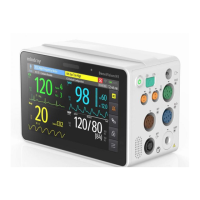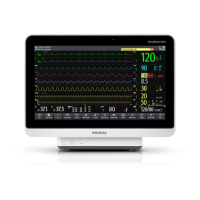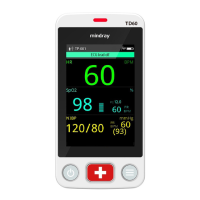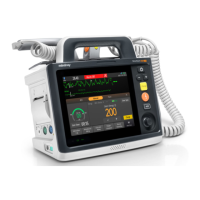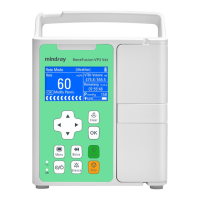A-9
ST Segment Analysis
Measurement range -2.0 to +2.0 mV RTI
Accuracy
-0.8 to +0.8 mV:
Beyond this range:
±0.02 mV or ±10%, whichever is greater
Not specified
Refreshing rate 10 s (Mindray algorithm), or per 16 heartbeats (Mortara algorithm)
Resolution 0.01 mV
QT/QTc Analysis
Measurement range QT: 200 to 800 ms
QTc: 200 to800 ms
QT-HR: 15 to 150 bpm for adult, 15 to 180 bpm for pediatric and neonate
QT Accuracy ±30 ms
Resolution QT: 4 ms
QTc: 1 ms
Alarm limit
Range Step
HR High (low limit + 2) to 300 bpm 1 bpm
HR Low 15 to (high limit – 2) bpm
ST High (low limit +0.2) to 2.0 mV
0.1 mV
ST Low -2.0 to (high limit – 0.2) mV
QTc High
200 to 800 ms
10 ms
ΔQTc High
30 to 200 ms
A.8.2 Resp
Technique Trans-thoracic impedance
Lead Options are lead I and II. The default is lead II.
Respiration excitation waveform <300 µA RMS, 62.8 kHz (±10%)
Baseline impedance range 200 to 2500Ω (using an ECG cable with 1kΩ resistance)
Bandwidth 0.2 to 2.5 Hz (-3 dB)
Sweep speed
3mm/s, 6.25 mm/s, 12.5 mm/s, 25 mm/s, or 50 mm/s
Accuracy: ±10%
Respiration Rate
Measurement range
0 to 200 rpm
Resolution 1 rpm
Accuracy
0 to 120 rpm:
121 to 200 rpm:
±1
Apnea alarm time 10 s, 15 s, 20 s, 25 s, 30 s, 35 s, 40 s
Alarm limit Range (rpm) Step (rpm)
RR High
Adult, pediatric:
Neonate:
(low limit + 2) to 100
(low limit + 2) to 150
1
RR Low 0 to (high limit – 2)
±2
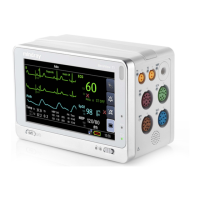
